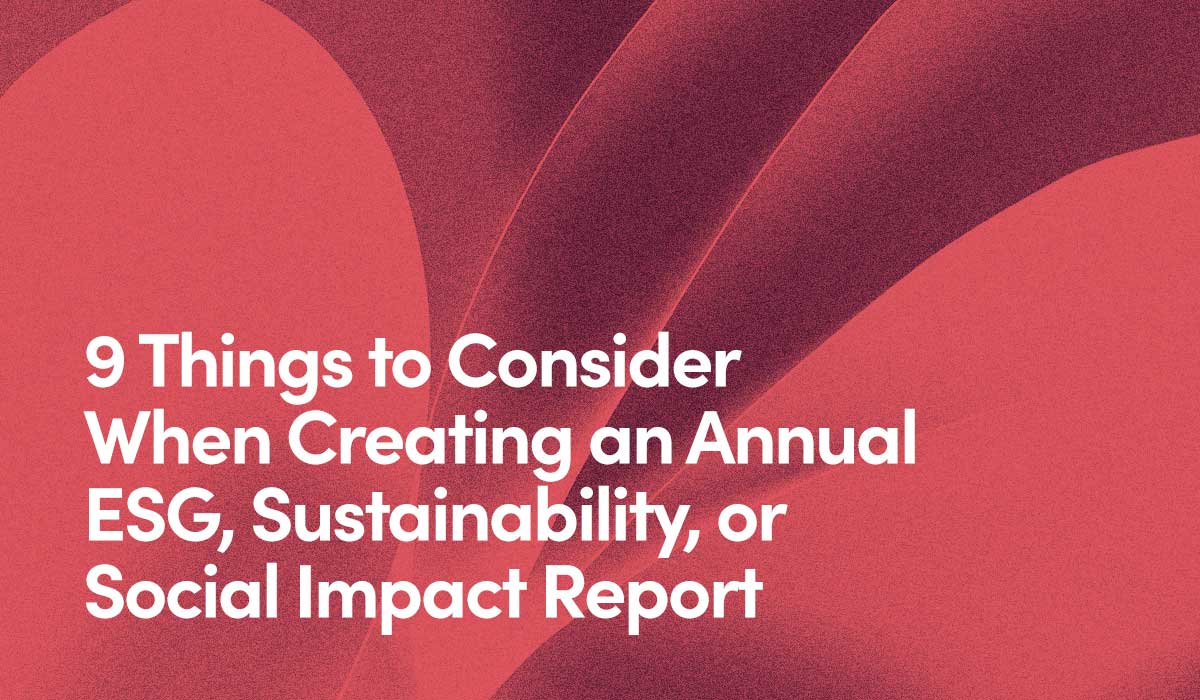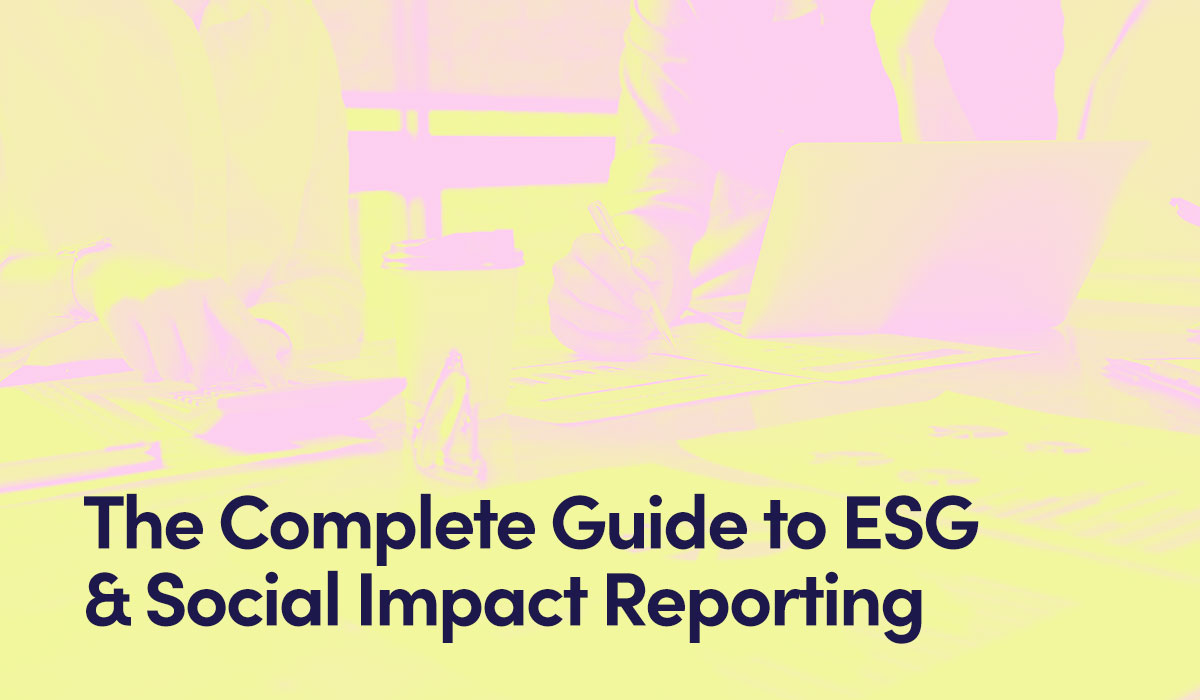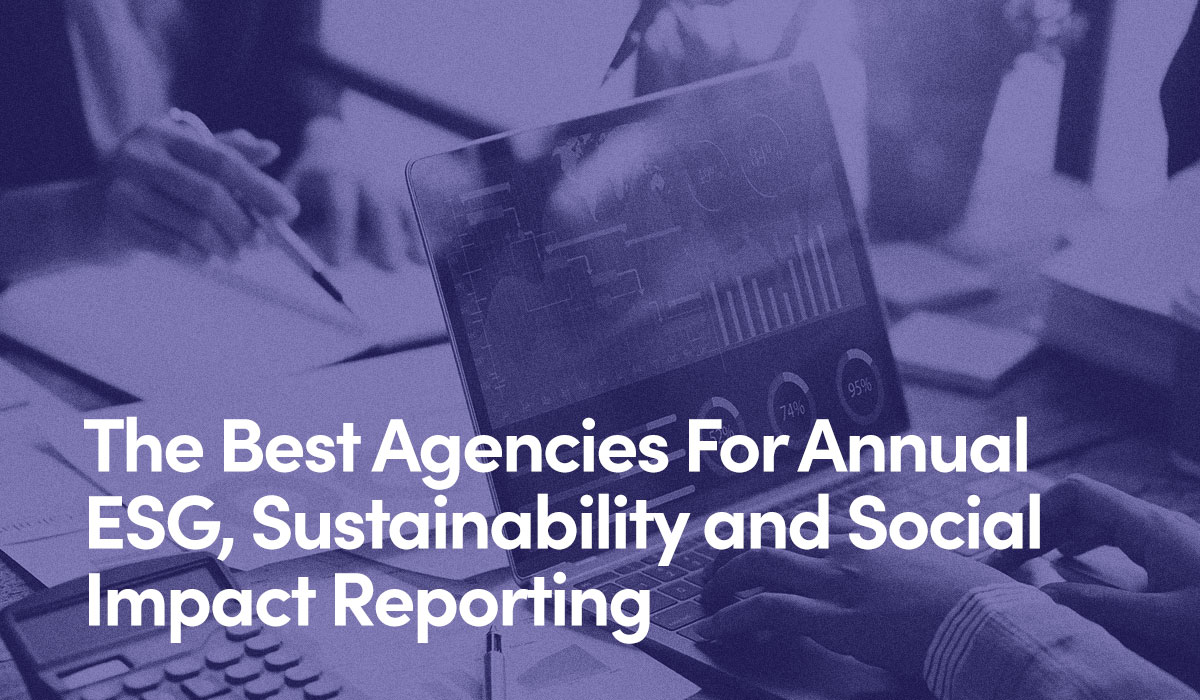Businesses today are increasingly expected to report on their ESG, sustainability, and social impact initiatives. But creating an effective report is no easy task. It requires careful planning, accurate data collection, and effective communication.
Here we outline the key things to consider when creating an ESG, sustainability, or social impact report that grabs the attention of stakeholders and drives positive change.
Building a Technically Sound ESG Report
Before we dive into the crucial considerations, the first step is to allot sufficient time for the process and avoid rushing through any aspect of it. Creating an effective ESG, sustainability, or social impact report is a process—one that requires careful planning, accurate data collection, and effective communication.
Rushing through the process of building a report can lead to inaccurate data, incomplete information, and poor communication with stakeholders. This can damage a company's reputation and erode trust. By taking the time to carefully plan and execute the report, organizations can accurately capture and convey their sustainability initiatives, engage stakeholders in a meaningful way, and set themselves up for long-term success.
Additionally, a well-planned and executed report can help companies identify areas for improvement and create a roadmap for future sustainability efforts, which can ultimately lead to increased efficiency, reduced costs, and improved financial performance.
The following guidance will help ensure this critical reporting.
1. Define the Scope
First, determine the boundaries of the report. What is the time frame being covered? What geographic regions are to be included in the scope? Which organizational units will have a voice in the project? To figure out the scope, consider the data you have access to, the information your stakeholders are generally interested in, and that which is most relevant to your industry.
More specifically, defining the scope of your ESG report promotes:
- Clarity & Transparency: Helps stakeholders understand the limitations of the report and its data, and prevents misunderstandings or misinterpretations.
- Relevance: Ensures that the report focuses on the most relevant and material ESG, sustainability, or social impact issues for the company and its stakeholders
- Consistency & Comparability: Enables stakeholders to track progress and benchmark performance, and helps companies identify areas for improvement.
- Regulatory Compliance: Upholds requirements of regulators, such as stock exchanges or securities commissions.
2. Set Objectives
Establishing the goals of the report and the purpose it will serve is critical to touching on all the points the report is meant to address. Organizations should consider the report's target audience, the type of information stakeholders need, and organization's key priorities.
Setting the objectives of the report goes a long way in achieving:
- Focus: Identify the specific ESG, sustainability, or social impact issues and goals that you want to address. This concentrates your efforts on the activities and outcomes that will enable you to achieve your organization's ESG goals.
- Motivation: Gives your company a sense of purpose and direction for your reporting. Clear and well-defined objectives inspire and energize people, and encourage them to work toward achieving their ESG, sustainability, or social impact goals.
- Measurement: Establishes benchmarks and metrics for tracking progress over time, and assesses whether you are making the necessary improvements to achieve ESG goals.
- Alignment: Positions reporting efforts across different departments and teams within an organization. When everyone is working toward the same set of ESG objectives, success can be more easily realized.
- Evaluation: Provides a basis for evaluation and feedback on the effectiveness of the report. By setting objectives, you can evaluate your performance and identify areas for improvement, which can then be used to refine and adjust strategies and activities in future reports.
Rushing through the process of building a report can lead to inaccurate data, incomplete information, and poor communication with stakeholders.
3. Gather Data
Collecting data on ESG, sustainability, or social impact indicators trains organizations to consider both quantitative and qualitative information. This includes data on greenhouse gas emissions, employee diversity, community engagement, sustainability goals, and more.
Taking the time to properly gather this important information benefits your reports by ensuring:
- Accuracy: Builds trust with stakeholders who rely on the report to make informed decisions about your company's performance.
- Transparency: Shows that your company is willing to disclose its performance and be held accountable for all actions and impacts.
- Materiality: Ensures that the report focuses on the issues most important and relevant to your company and stakeholders.
- Benchmarking: Provides valuable insights into how your organization is performing relative to others in the industry, and where improvements can be made.
- Continuous Improvement: Helps identify trends, evaluate the effectiveness of ESG, sustainability, or social impact initiatives, and make informed decisions about where to allocate resources and efforts for improvement.
4. Analyze & Interpret Data
After gathering data, the natural next step is to evaluate and interpret it to determine its alignment with organizational goals and objectives. This encompasses identifying trends and performing a strengths, weaknesses, opportunities, and threats (SWOT) analysis.
Analyzing and interpreting your company’s gathered data opens the door to:
- Contextualization: Enables stakeholders to understand your company's performance in the specific context of its business operations, industry, and broader societal and environmental trends.
- Insight: Displays the effectiveness of your ESG, sustainability, or social impact initiatives and strategies. This helps you identify areas for improvement and refine your approach.
- Communication: Presents data in a clear and meaningful way so that you can effectively communicate the significance of your performance and how it addresses risks and opportunities.
- Engagement: Fosters relevant and meaningful dialogue on ESG, sustainability, or social impact issues between you and the target audience of the annual report.
- Accountability: Demonstrates your commitment to responsible business practices and signals that you are willing to be held accountable for your actions and impacts.
5. Develop Content
You should create the report's content based on the analysis you’ve gathered, analyzed, and interpreted. Report content can include a description of the organization's social impact strategy, key achievements, challenges, and plans for improvement. This step involves crafting a narrative that is compelling and easy to understand, using a combination of text, visuals, and data.
Developing dynamic content promotes:
- Clarity: The content should be concise, relevant, and accessible, making it easier for stakeholders to understand the company's performance and initiatives related to ESG, sustainability, and social impact.
- Relevance: The content should address the material issues and risks facing the company, and provide insight into how the company is managing these issues.
- Credibility: The content should be based on reliable data, and provide a balanced view of your company's performance around ESG, sustainability, and social impact, including both strengths and weaknesses.
- Differentiation: The content should demonstrate your company's unique approach to ESG management, and display evidence of your commitment to responsible business practices. This helps you stand out in the market.
Showcase Your Positive Impact on the World
Want to Connect With Values-Driven Consumers and Investors?
Amplify Your Story With Social Impact Reporting arrow_forward6. Design the Report
Creating a visually appealing and engaging report is crucial to keeping the attention of your audience, while also informing them of your achievements related to ESG, sustainability, and social impact. These annual reports are most successful when data is presented in a clear, concise, and easy-to-understand format, using tables, graphs, charts, and images to convey the story effectively.
Your report’s design boasts similar advantages to our previous step of developing content, including:
- Clarity: The design should be visually appealing, with clear headlines, subheadings, and graphics, making it easier—and more enjoyable—for stakeholders to navigate the report and find pertinent information.
- Consistency: The design should be consistent with your company's branding and visual identity, and use standardized metrics and reporting frameworks where applicable.
- Accessibility: The design should take into account the needs of different stakeholder groups, including those with visual impairments or limited English proficiency, and ensure that the report can be accessed in different formats, including in print and online.
7. Review & Approve
Conducting a review and approval process ensures that the report is accurate, clear, and consistent with the organization's values and brand. It must adhere to relevant reporting standards and guidelines, such as the Global Reporting Initiative (GRI), and Sustainability Accounting Standards Board (SASB).
A comprehensive review and exacting approval process strengthens the report so that it is less likely to face criticisms and negative feedback. This step also offers many of the same benefits as others on this list, including:
- Accuracy: There must be a careful examination of the data and information presented in the report to ensure that it's based on reliable sources, and that any assumptions or estimates are clearly stated.
- Consistency: Be sure to compare all the information presented in the report with your company's policies, standards, and practices to ensure that there are no inconsistencies or gaps.
- Compliance: This should involve a thorough review of the report so that it complies with all relevant laws and regulations, including those related to reporting around ESG, sustainability, and social impact.
- Accountability: Senior management or the board of directors should review the report to ensure that they are aware of the company's performance and can be held accountable for any deficiencies or areas for improvement.
- Reputation: A well-reviewed and approved report can demonstrate the company's commitment to responsible business practices and enhance its reputation as a trustworthy and transparent corporate citizen.
8. Publish & Communicate
Once the report has been reviewed and approved, it should be released to stakeholders and promoted through various channels, such as the organization's website, social media, press releases, or events. This demonstrates your commitment to sustainability and responsible business practices, which can result in long-term benefits.
Publishing your report for the world to see ensures that all its information is released on your terms, facilitating:
- Image Management: An ESG, sustainability, or social impact report manages your organization's reputation by showcasing positive social and environmental impact, as well as a commitment to good governance practices.
- Risk Management: It identifies and manages risks related to social and environmental issues, such as climate change, human rights violations, or supply chain disruptions.
- Competitive Advantage: By publishing an ESG, sustainability, or social impact report, you can differentiate your company from the competition and attract socially responsible investors or customers who prioritize sustainability and ethical business practices.
9. Monitor & Evaluate
Finally, monitoring the impact of your report on stakeholders' perceptions enables you to track progress against objectives and use feedback to improve future reports. This involves tracking key metrics, soliciting feedback from stakeholders, and evaluating the report's effectiveness in achieving its objectives.
This final step in the process presents three concrete benefits:
- Identify Opportunities: By tracking key indicators over time, you can pinpoint trends and patterns, and take corrective actions to improve performance around ESG, sustainability,and social impact.
- Track Progress: Measure your company against the goals and targets identified in the report. This demonstrates your commitment to responsible business practices.
- Improve Reporting: Identify inconsistencies in the data or information presented in the report, and take corrective actions to improve its accuracy.
Follow a Comprehensive Approach When Building an ESG, Sustainability, or Social Impact Report
Harvard Business Review found that companies that take a comprehensive approach to sustainability tend to have better financial performance than those that do not. This encompasses clear goals and targets, stakeholder engagement, accurate data collection and reporting, analysis of sustainability performance, effective communication, and plans for improving sustainability initiatives.
Such a comprehensive approach can help companies identify areas for improvement, set goals, and communicate progress to stakeholders. By prioritizing sustainability in this way, companies can create long-term value for shareholders, while also addressing the social and environmental challenges facing our world today.
Key Takeaway
Creating an annual ESG, sustainability, or social impact report is a crucial step for businesses looking to drive positive change and meet the expectations of their stakeholders. By carefully defining goals, choosing the right framework, collecting accurate data, analyzing performance, communicating effectively, and outlining next steps, businesses can create a report that not only informs stakeholders but also inspires action.
As expectations for corporate sustainability continue to rise, now is the time to invest in creating a powerful ESG, sustainability, or social impact report that can help your organization stand out and make a meaningful impact.
Whether you’re considering working with a new social impact reporting partner or just starting, we can deliver a compelling impact narrative that clarifies your message, amplifies your mission, and empowers customers, investors, and talent to better engage with your brand. Learn more about our impact reporting capabilities and how we can leverage them to bring your impact story to life.




